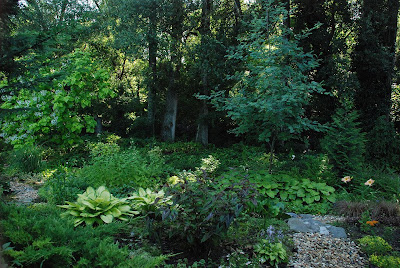
This Japanese maple unfortunately has already died. The same happened to three other ones as well. I did not understand why, for we did all our best. We planted it in the right soil, in part-shadow, and watered it abundantly.
By this spring almost all our magnolias were damaged, too. They started to display signs of sickness in the second part of last summer. They looked as if they got some kind of mycosis, or as if they suffered of some deficiency. They suddenly displayed symptoms of chlorosis and a very spectacular degradation. We watered them much more than usual and sprayed them with all kinds of plant-protecting agents, but in vain.
I was desperately searching the internet for a specialist who could help us. I found one, an assistant professor of the chair of pathology of the Budapest university of horticulture, and she was willing to come out. She immediately told that the soil is certainly bad, that we do not water them and do not care them enough, and so on. I tried to convince her that the reality is quite the contrary, but she did not seem to be interested in reality. Incidentally she also mentioned that there exists a kind of mycosis, but it never attacks magnolia.
I browsed through the web again. I started to systematically search for the diseases of magnolia. Soon it turned out that in fact there is a fungus living in the soil that also attacks magnolia. The symptoms corresponded to those displayed by our plants. It is called Verticillium wilt, and indeed there is no effective protecting agent against it. Nevertheless, there is a small chance that the plant itself will win it. The only thing one can do is to give strength to the plant by foliar fertilizing. (As I understood, our magnolia had already overcome this infection some years ago when I started to apply on it a foliar fertilizer called Wuxal.)
Not only magnolia, but other kinds of plants are sensitive to it as well. Wherever this fungus once occurred in the garden, you should better not plant them.
Plants threatened by verticillium wilt:
ash, azalea, Japanese barberry, Corean box, American (wild) chestnut, catalpa, cherry and other stone-fruits, currant, gooseberry, some sorts of cornel, elder, elm, honeysuckle, syringa, some sorts of lime, maple, magnolia, some sorts of oak, plum, some sorts of rose, some sorts of sorb, sumac, spirea, fustet, haw.
All the plants in the above list that we had in our garden, either displayed symptoms of deficiency, or died, in spite of all our care and efforts.
There are, however, some sorts that are
resistant to verticillium wilt:
apple, Western arbor vitae, beech, birch, some sorts of cornel, Scotch fir, ginkgo, Western swape, thornapple, honeylocust, juniper, redwood, mulberry, some sorts of oak, some sorts of lime, pear, poplar, some sorts of sorb, spruce, chestnut, willow.
Some web pages for more information about verticillium wilt:
-
Online gardener-
Univerisity of Minnesota-
Elm care-
RHS To the left I see the forest.
To the left I see the forest. Here I can still catch a glimpse of the rising sun among the crowns of the trees.
Here I can still catch a glimpse of the rising sun among the crowns of the trees. In front of us there is also the forest and our part-shadow garden.
In front of us there is also the forest and our part-shadow garden. Daylilies seen from near.
Daylilies seen from near. And from even nearer (Hemerocallis 'Victorian Fantasy'.)
And from even nearer (Hemerocallis 'Victorian Fantasy'.) To the right, in the middle, another part-shadow parcel. In the middle of the picture, one of my favorites: Persicaria microcephala 'Red Dragon'.
To the right, in the middle, another part-shadow parcel. In the middle of the picture, one of my favorites: Persicaria microcephala 'Red Dragon'. To the right the part-shadow garden continues.
To the right the part-shadow garden continues. The young catalpa seen in the previous picture, now nearer to us. Its flowers are very fragrant.
The young catalpa seen in the previous picture, now nearer to us. Its flowers are very fragrant.































